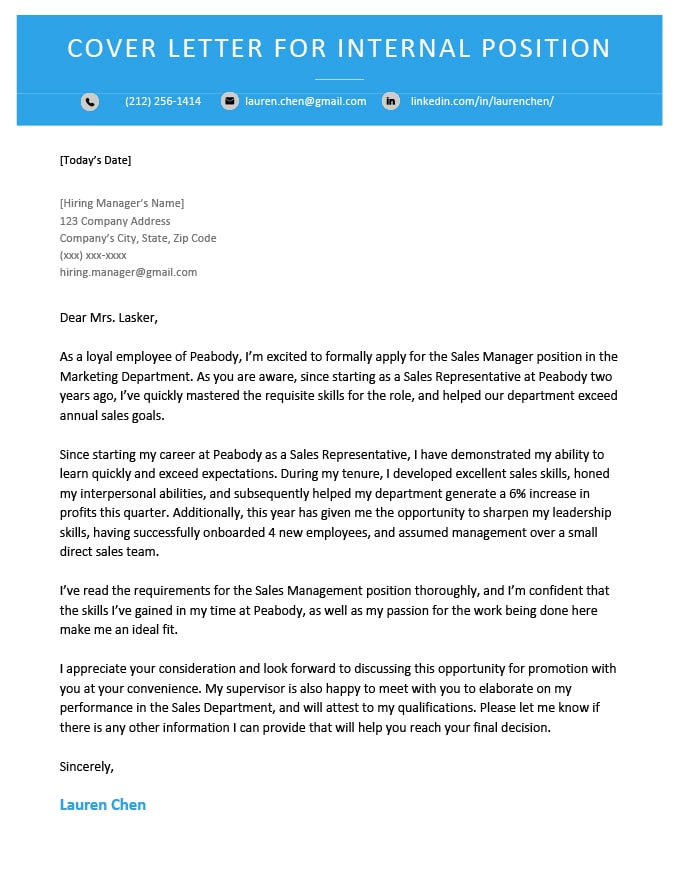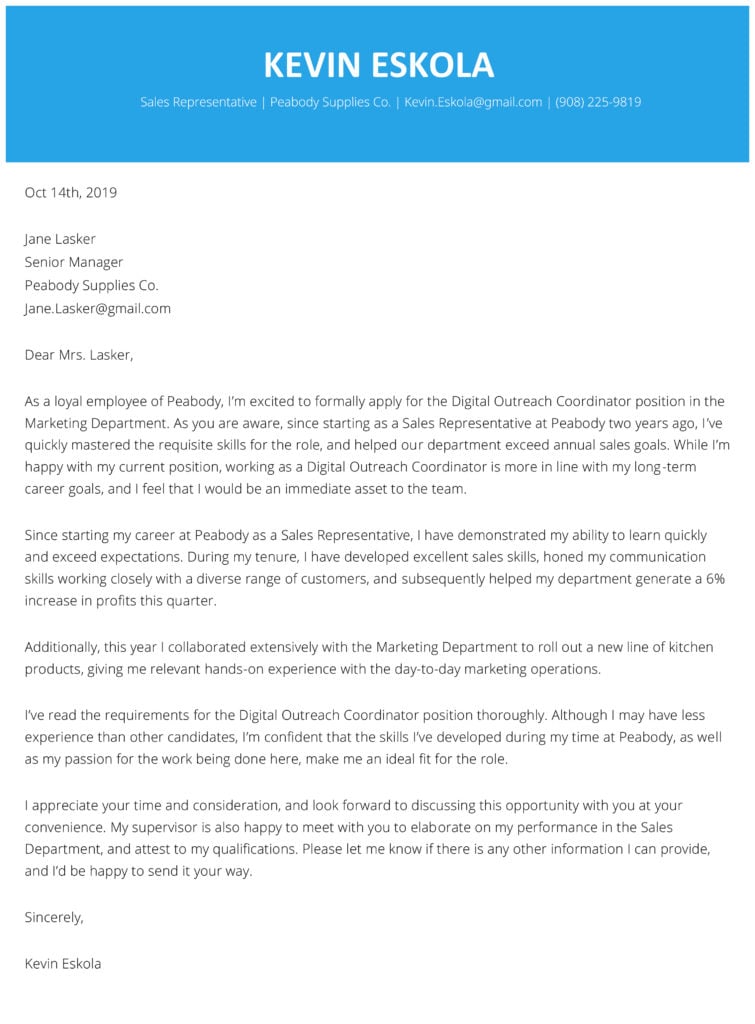Cover Letter for Internal Positions or Promotions- When changing jobs, most people think of an external change and another employer. However, a professional career is often possible in your own company – with an internal job change.
What many applicants do not realize, however, is that many risks and mistakes are lurking around.
Therefore, an internal application (Cover letter and resume) takes less time and effort than an external one.
Read Also:
- Best Cover Letter Samples for 2023 (All Jobs)-Drjobpro.com
- PS: Your Cover Letter is the Reason for Not Getting A Job
- 5 Secrets: How to Use COVER LETTER to Get a Job
This blog will guide you on tips to consider and how to write a Cover Letter for Internal Positions or Promotions...
What is an internal application?

Changing jobs internally often increase salary and the assumption of higher (management) tasks.
Read Also:
Guide to Conflict Resolution Skills and Techniques
Advantages of an internal application

- They only change professionally. You may earn more money for no moving, extended training, or adjustment periods. Changing jobs internally is convenient.
- You know the company. You are familiar with the corporate culture and day-to-day work and can identify with them.
- You know the coworkers. The employees of a new department may not be quite as familiar as their colleagues. Nevertheless, there is contact with each other through company parties or previous changes.
- You are at the source. Your direct contacts give you easier access to information about the new position and new managers. In addition, direct contact enables a comparison between the tender and reality. Such details are usually not disclosed in job offers.
- The employer saves time and money. Recruiting costs are reduced for the company. Promoting your employees is also cheaper and increases loyalty, motivation, and productivity.
Challenges of an internal application

- During a transitional period, they help find an optimal successor.
- You agree that ongoing projects will only be completed before you move to the new position.
- You promise to train your successor thoroughly before you leave.
How do I find internal vacancies?

- Networks (branch experts)
- Bulletin board (posting, intranet)
- Job boards (company career page)
How do you write internal applications?
In general, the structure of the internal application does not differ significantly from that of the external one. Only the attachments and job references are omitted, which is why it is similar to a short application.
Read Also:
- Job Application Email: How to Write (Ultimate Guide)-Drjobpro.com
- How to Write Leave Application for Office (With Format)
- 3 Tips to Hear from Employers About Your Applications
Structure of the internal application
What documents belong in an internal application? The (complete) internal application consists of these documents:
- Cover letter (1 page)
- CV (2 pages)
- Certificate (optional)
- References, letters of recommendation, project lists (max. 3)
You may compete with peers and external candidates. Maybe people don't know enough about your strengths, or your previous self-marketing was suboptimal. You also have to ask yourself: if you are the ideal candidate for the new position, why haven't you been asked before?
Either way: The internal application is not a sure-fire success!
Cover Letter for Internal Positions or Promotions tips

- Letterhead
- Personal data (name, department, e-mail)
- Date (right-aligned)
- Recipient (name, address, department)
- "Application for position _____" / "Application as _____"
- Reference number or job ID (if known)
- Salutation
- "Dear Sir or Madam," (if necessary)
Ideally, it would help if you aroused interest with the introduction or the first sentence of the application. It should not contain phrases ("I wish this apply as..."). But you can score even more points with your motivation and professional perspective when formulating it.
For example like this:
• "I read with interest that you are looking for an account manager in the new division _____. Therefore, I want to take this opportunity to develop further within the company and am applying for the advertised position."
• "The new position "_____" fits perfectly with my professional development. I am applying for this position to face this new challenge and at the same time take the next step..."
Body
This includes your professional skills, soft skills, and particular (project) experiences. Work out what advantages the employer has from the internal change. Demonstrate your deep engagement with the position by addressing ALL the requirements stated in the job posting. But no bragging: After all, you are well known, and your achievements and successes can be checked.
Example are:
• "My ____ years of experience as ____ in the ____ department prepared me perfectly for the vacant position. I improved my communication skills when looking after our customers and trained my organizational and leadership skills when managing various projects. I want to bring these skills to the new position and expand them profitably for our company."
• "I will graduate as a ____ in three months. I was able to gain a lot of experience in the field of ____ and ____. I would now like to use this to face the exciting challenge of developing a new market for us. I am convinced I can create added value for our company primarily through my ____ knowledge."
Ending
Formulate concisely: Simple main endings are better than long, convoluted sentences. It would help if you exuded self-confidence in the application letter's final part (and final sentence ).
The subjunctive is taboo - it weakens your previous statements. Positive words like "like" or "I'm happy" have a sympathetic effect. Or add a reason to the final sentence why you are looking for a face-to-face interview.
For example, to convince with professional skills. Successful examples of this are:
• "As you can see, thanks to my many years of work in the company, I am extremely well qualified and highly motivated for the new position. I look forward to proving this to you in a personal conversation."
• "I would be happy to convince you in a personal interview that you will gain a committed and experienced employee in me."
Salutation and signature
End your cover letter with "best regards" or "colleague greetings." The handwritten signature (no scan!) not only gives the internal application a personal touch.
It also documents that the information provided is accurate.
The cover letter should not be longer than one A4 page in total.
Resume for Internal Positions or Promotions tips
Even if your traditional CV is available to the human resources department, you must update it for the internal application.Your previous experiences, successes, and competencies shouldn't just be used for the current position. Instead, those relevant qualifications that best justify further professional development must catch the eye of the HR decision-maker.
These include, above all:
- Project experiences
- Quantifiable achievements
- Further training and certificates
- Relevante Soft Skills
- Special Knowledge
- Maximum three pages long (shorten earlier positions if necessary)
- Chronological structure
- Subdivision into sections (desired job, career, education, special knowledge, interests)
- Left: times (MM/YYYY – MM/YYYY), suitable: activities
- Place, date, and signature at the end
- Maximum of two different fonts and sizes
Read Also:
- 8 Samples of Career Objective for Resume
- How Many Jobs Should You Put on Your Resume?
- 15 Essential Job Skills to Put on a Resume in 2022|Drjobpro.com
- Record a Video Resume Without Being On Camera:10 Tips Inside |DRJOBPRO.COM
- How To Write A Video Resume Script: Your Ultimate Guide
In the case of an internal application, your previous work references are already in the personnel file. So you don't have to submit it again. However, if you have received an internal reference or a letter of recommendation from your current supervisor, you should attach this to your application and the attachments.
References from former customers, mentors, or supervisors can be advantageous. It enhances the internal application enormously and can give you a clear competitive advantage. Before you apply, ask yourself who could issue you such a letter of reference.
Because you have been with the company for many years, you should also know what qualities your employer values. Make clever use of this insider knowledge by building on it in your documents.
Ideally, however, your advocates should also name previous achievements and relevant qualifications, thereby underlining that you are the ideal person and the perfect candidate.
How do I write an informal internal application?
The purpose of the informal application is to save time and paperwork. The informal application contains little more than a short cover letter (1 page) and a compact tabular CV (1 page).It would help if you shortened your CV more for this.
Formulate activities in keywords, mention only skills that count for the job, eliminate all redundant elements, and offer no recognizable added value.
Nonetheless, the information required from the job advertisement – for example, salary expectations or the starting date – must not be forgotten.
8 errors in the internal application
An internal application can be an opportunity. Ideally, you will find out first-hand and long before a job advertisement is published that new career opportunities are opening up for you.However, it would help if you avoid the following mistakes:
• You underestimate the effort
An internal application is no less work-intensive than applying externally. On the contrary: In the worst case, you have to reckon that your boss will be reluctant to let you go. Therefore, you should also consider obstacles and plan enough time.
• They take the cover letter lightly
Formulations along the lines of "I am applying for the advertised position; please refer to the CV for my qualifications" are rarely well received. Instead, you should provide clear evidence of your professional development since day one.
• You underestimate the competition
Remember that other applicants may also have excellent skills. This applies not only to internal competitors but also to external competitors.
• You're being overly confidential
Be professional and formulate words without coming across as clumsily confidential. You never know who is reading your internal application. Therefore, avoid using the first name (unless the DU applies company-wide). Your application will end up in the personnel file. So show consistently that you are serious and professional.
• You are indiscreet
If you tell colleagues about your internal application from the start, you are not only breeding potential competition. You risk snide comments if you get rejected.
• You do not clarify your motives
You should also know your exact motivation for an internal job change. Withdrawing the internal application after you have sent it seems latently unprofessional.
• You trust your reputation
Just because others know about your qualities doesn't mean the potential boss knows anything about them. Don't be too sure of yourself; provide solid evidence in the form of certificates and references and document this knowledge accordingly in your cover letter and CV.
• You put salary first
Salary should never be your official motivation. If you come for money, you go for money. You are outing yourself as a monetary opportunist. The reason for your application, on the other hand, should always be professional development or reorientation.
Cover letter for internal position example

Cover letter for promotion example

Get the perfect cover letter now?







 2025-02-27
2025-02-27
 2025-02-21
2025-02-21
 2025-01-23
2025-01-23
 2024-12-16
2024-12-16
 2024-12-09
2024-12-09